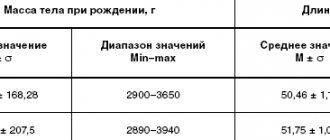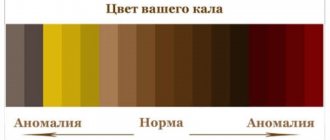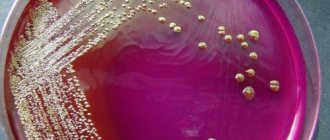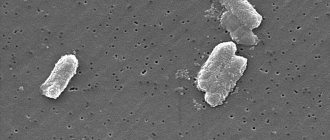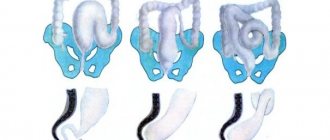Sometimes parents have to deal with things that don't happen often in life. Such situations are frightening, and it is not entirely clear how to continue to behave with the baby. Black strings were found in the child's stool - this is one of these moments. Whether you should immediately run to the doctor or wait until this symptom goes away on its own can be determined by what foods your toddler’s diet consists of. The immature digestive system of infants, especially if a banana or apple was introduced to the diet for the first time, may react to these foods in this way.
Black strings in stool
Black strings in children's feces are nothing more than undigested iron particles, and you should not be afraid of this. In an older child, this phenomenon may occur after he has eaten a large amount of persimmon or kiwi. Moreover, it is worth paying attention to the fact that the iron contained in these products can be excreted from the body of a small person not only in the form of thin threads painted black, but also in the form of dots the size of a poppy seed.
The intestines are completely cleared of meconium on the third day of the child’s life. During this period, the consistency of the stool, its smell and color change (original stool has no odor). Feces take on a bright yellow or brownish color and a mush-like consistency and may contain small amounts of inclusions and particles of undigested food. Black strings on the 3-4th day after birth may be remnants of meconium, so in the absence of other unpleasant symptoms (bloated tummy, high temperature, etc.) there is no need to worry.
If by the end of the fifth day black threads in the stool persist, you should contact a pediatrician or neonatologist. Partial passage of meconium during this period may be associated with increased viscosity of feces, which is an unfavorable clinical symptom and may indicate congenital pathologies, for example, cystic fibrosis or meconium ileus (obstruction). Depending on the results of the examination, the child is prescribed medication or surgical correction.
Diarrhea with mucus
Diarrhea with mucus is a cause for concern
Particular attention should be paid to the moment when a child experiences diarrhea with mucus. This is the main symptom of dysbiosis, which appears mainly after taking strong antibiotics that have completely killed the beneficial intestinal microflora. To find out for sure whether a child has dysbiosis, it is necessary to undergo special stool tests, which will show the content of beneficial and harmful bacteria. It is not uncommon when there are practically no beneficial bacteria, and it is during this period that the child begins to experience diarrhea with mucus, which is sometimes accompanied by sharp pains in the stomach. After the pain subsides, the child goes to the toilet.
In most cases, the urge to defecate appears literally ten minutes after eating, and the child will strain as if the stool is not liquid, but very hard.
It must be said right away that you should not be afraid of dysbiosis, since it can be controlled with the help of prebiotics, which will help restore the intestinal microflora and improve your general condition. In addition, the inclusion of fermented milk products in the diet will also have a positive effect and affect the rate of intestinal recovery. If we talk about medications, then if diarrhea with mucus appears, it is necessary to give the child Smecta. It is an excellent absorbent and removes all harmful substances, and also helps strengthen the stool. The dosage depends on the age of the baby.
If, in parallel with Smecta, the doctor prescribed some other drugs for the treatment of dysbiosis, then they should be given strictly two hours after taking Smecta, since the drug can simply be eliminated without starting to act. If diarrhea with mucus is repeated many times, and the child is small enough, it is better to call an ambulance or go to see a pediatrician, who will recommend medications that can help alleviate the child’s condition.
Possible reasons for the appearance of black strings in feces
In most cases (more than 80%), such a clinical symptom is not a sign of any pathology and is associated with the characteristics of digestion in children. If parents notice any inclusions, veins, dots or black threads in the stool, it is necessary to carefully analyze the child’s nutrition and actions over the past 24 hours: perhaps the cause of this phenomenon is completely harmless, and there is no reason to worry.
Hygiene problems
This is one of the most common reasons for the appearance of black threads in the stool in children in the first year of life (mainly from 6 months to 1 year). The development of sensory perception (sense organs) at this age occurs through direct knowledge of surrounding objects, their sizes, shapes and properties. Children are especially active in exploring their surroundings with the help of their taste organs, that is, they put into their mouths everything they can reach and grab with their hands.
Small children put everything in their mouth, so various foreign objects can get into their stomach. Hair, threads, and pieces of tinsel can get into a child's stomach. If there are animals at home, there is a high probability of accidental ingestion of fur, so in areas where children under 12 months live, wet cleaning should be carried out regularly.
Ingestion of wool, dust and hair in large quantities can cause not only changes in stool, but also functional dyspepsia, which is manifested by bloating, abdominal pain, regurgitation (less commonly, vomiting), sleep and appetite disorders. The amount of digestive enzymes in the infant's gastrointestinal tract is insufficient to digest foreign substances, so they are usually excreted from the intestines undigested.
Iron supplements, activated carbon
The cause of black stools is medicinal substances containing iron. These can be either iron preparations or vitamins or dietary supplements that contain this element. In artificial babies, mixtures with large amounts of iron can cause black stool. Also, the stool of a child who was given activated charcoal takes on a black color.
Medicines that can cause black stools also include anti-clotting medications and anti-inflammatory drugs. By themselves, they do not change the color of the stool, but can cause internal bleeding, manifested by black diarrhea.
If the amount of incoming iron exceeds the daily norm, the body cannot always digest and break it down, which leads to the appearance of black thread-like streaks and other characteristic symptoms of an overdose. These include:
- metallic taste in the mouth;
- bitterness after eating or drinking liquids;
- cramping abdominal pain;
- skin rash.
Table. Daily iron requirement
| Age | Iron intake per day (mg) |
| Newborns | 0,25 |
| Infants 1-6 months | 0,3 |
| Infants 7-12 months | 10,9 |
| Children 1-3 years old | 7,2 |
| Children from 4 to 12 years old | 10-11 |
| Teenagers over 12 years old and adults | 11-18 |
| Aged people | 8-10 |
When the cause of the medicine
Medicines for children are mainly eliminated from the body naturally, along with feces. This process may be accompanied by some changes in the stool. Black threads may appear after treatment:
- sorbents;
- drugs to increase hemoglobin;
- vitamins with a large number of microelements.
Treatment with sorbents can cause the stool to be completely black. This is a common occurrence as all toxins and waste are removed from the body. In this case, you should not stop taking sorbents. If the child was prescribed bacteria to populate the intestinal microflora, then black threads may be present in the stool. Because the balance of bacteria is being established.
When using drugs with iron, such changes are also observed. Children often experience anemia. The decrease in hemoglobin is restored with the help of iron in the form of tablets or syrup. Therefore, black threads in the stool after using it are normal. Adults also often experience this.
Nutritional Features
A very common reason for the formation of black threads in a child’s feces is an increased content of fiber-rich foods in the diet. Fiber is a coarse dietary fiber that is found in many plant foods and helps support digestion and cleanse the intestines of toxins.
Fiber is not affected by digestive enzymes, but at the same time it provides a breeding ground for beneficial bacteria that inhabit the intestinal microflora. Dietary fiber is necessary to support immunity, normalize weight, and prevent heart and vascular diseases (fiber prevents the absorption of bad cholesterol, which can form cholesterol plaques and cause blockage of blood vessels).
If a lot of plant fiber enters the gastrointestinal tract, it can leave the intestines unchanged in the form of threads and small dark spots. Pathological causes of insufficient digestion of coarse fiber in childhood may be:
- diseases of the digestive system (colitis, gastroenteritis, gastritis, irritable bowel syndrome);
- intestinal dysbiosis (lack of beneficial microorganisms that normally process fiber and break it down);
- celiac disease.
If the child is not yet one year old, such a clinical picture is the norm, since before this age the baby’s digestive system is considered immature. Especially often, black strings in the stool can be found during the introduction of the first complementary foods (fruit and vegetable puree).
In order not to succumb to false panic, you need to know which fruits are rich in fiber, and if a pathological digestive reaction is detected, you should limit their amount in the children's diet.
Table. Fiber content in vegetables and fruits
| Product | How much fiber is contained in 100 g |
| Red and white beans | 2.4 g |
| Cabbage (white, red, kohlrabi, broccoli, cauliflower) | 2.0-4.4 g |
| Carrot | 2.5 g |
| Beet | 3.3 g |
| Greens (rosemary, basil, cilantro, parsley, green onion, fennel) | 2.1-2.9 g |
| Kiwi | 2.8 g |
| Oranges and tangerines | 2.1-2.3 g |
| Persimmon | 2.6 g |
| Bananas | 2.7 g |
Small black strings in the stool may be the result of eating a large amount of fruits and berries containing small seeds (grapes, kiwi, gooseberries, etc.). The child may also experience slight dilution of stool, but diarrhea and other unpleasant symptoms should not normally be present.
Dysbacteriosis in an infant or fortune telling by the contents of diapers
Authors : La Leche League International
Very often, parents of infants in Russia are faced with the need to get tested for dysbacteriosis, and then treat it. The situation usually develops according to the following scenario: the child has liquid stool compared to children on artificial breast milk substitutes and adults, or greenish stool, or foamy stool, and the doctor recommends testing for dysbacteriosis. Prescribed treatment usually involves taking medications containing beneficial probiotic bacteria and yeast. In the worst case, they sin on breast milk and recommend switching the child to other types of feeding. What is dysbiosis? Does it occur in infants? What to do if a child is diagnosed with this? Should I worry? (author's note: Here I'm going to get ahead a little to reassure all mothers. Dysbiosis in infants is an unheard of thing!) Let's step by step understand the question that absorbs the minds of all mothers in all corners of the planet - the contents of the baby's diapers and what it means.
Contents of the intestines and diapers of a healthy baby During the period of intrauterine development, the gastrointestinal tract (GIT) of the fetus is sterile. There are no bacteria or other microorganisms there. When a baby is born, the gastrointestinal tract is colonized, or colonized, by bacteria that enter the baby's mouth as it passes through the mother's birth canal. This is how normal and healthy intestinal microflora is created. After birth, the baby’s gastrointestinal tract is colonized by bacteria that are found in the environment, in the mouth and on the mother’s skin. This occurs during breastfeeding, when kissing and touching the baby. Breast milk contains bifidus factor, a substance that promotes the growth of bifidobacteria. It is not surprising that bifidobacteria make up 95-99% of the intestinal flora of breastfed children. Bifidobacteria, sometimes called probiotics, are part of healthy intestinal flora. Yes, yes, these are the same probiotics that are usually prescribed as a treatment for dysbiosis. These good “knights” promote digestion, normal functioning of the immune system, and also prevent the growth of potentially pathogenic bacteria that lead to diseases. Bifidobacteria predominate in the intestines of the infant as long as breast milk constitutes the majority of the infant's diet. In addition E. Coli ) can live in small quantities in the baby's intestines . All these microorganisms are normal flora of the digestive tract of a breastfed baby. Immediately after birth, the baby begins to nurse and receives colostrum, which has a laxative effect. This helps to quickly get rid of the newborn's first stool - meconium. Meconium is black, sticky, tar-like stool that is odorless. With frequent feedings on the first day, meconium is expelled within the first 48 hours. As milk comes in, the newborn's stool changes from dark to lighter. Transitional stool is usually greenish in color and thinner than meconium. Around the fifth day of a child's life, his stool becomes yellow, similar to mustard or thick pea soup, often grainy, interspersed with pieces of cottage cheese. The color of an infant's stool can range from yellow to yellow-green or yellow-brown. Occasionally, the stool may be green or foamy. In the first three days after birth, the number of bowel movements usually increases from 1 to 3 times per day. After the milk comes in, many infants have bowel movements 3-4 times a day (or maybe more often), and the amount of stool can be quite significant. As they grow older, around 6 weeks from birth or a little earlier, many infants switch to more infrequent bowel movements - from once every few days to once a week or even less often. In this case, there are no signs of constipation (dry, hard stool) - the baby’s stool is still unformed, puree-like. The introduction of any other food besides breast milk will lead to a change in the consistency, color and smell of the stool in an infant. If you start introducing complementary foods, you may notice bits of the food you give your baby in your stool. The defecation and stool norms of infants differ significantly from the norms of adults. What would be a sign of concern and a reason to see a doctor in adults is the norm in infants .
What is dysbacteriosis Dysbacteriosis (from the gr. dys- “disorder, disorder”, bacterio- “bacteria” and –sis “condition”) or dysbiosis is a violation of the qualitative or quantitative balance of microorganisms in the body, in this case, in the intestines. This means that the proportion of bacteria in the intestines has changed or microorganisms unusual for normal flora have appeared there. It is difficult to identify symptoms of dysbiosis, since this condition is not a disease according to the International Statistical Classification of Diseases and Related Health Problems, Tenth Revision (ICD-10) - a document of the World Health Organization, which is a generally accepted international diagnostic classification in healthcare.
How indicative are tests for dysbacteriosis in healthy infants? The study of the composition of the intestinal flora in a healthy infant, that is, a child without visible symptoms of a disease, in this case diarrhea, is of interest to scientists, but not to parents or medical practitioners. Numerous studies have shown that breast milk protects children from disease, even if the intestines are colonized by pathogens. For example, breast milk contains antibodies and factors against E. coli, Vibrio cholerae, Salmonella, Shigella, rotavirus and Giardia. This means that a pathological microorganism can be sown in the stool, but the child does not show any symptoms of the disease.
What does a nursing mother need to know and remember? Breastfeeding is the real insurance for the health of the child’s gastrointestinal tract during the first years of life. Breast milk promotes the growth of bifidobacteria, which prevent pathogenic bacteria from colonizing the intestines, and also contains antibodies and factors that protect the baby from illness, even if pathogenic bacteria have managed to take root in the intestines. Breastfeeding helps restore the balance of the baby's intestinal microflora after antibiotic treatment. Simply put, dysbiosis is not scary for infants.
Source
published 01/24/2014 15:50 updated 01/08/2017 — Diseases of the gastrointestinal tract, Natural feeding
Can threads be black worms?
Inclusions in stool that resemble black worms in appearance can occur as a result of eating bananas. Such inclusions are often perceived by adults as worms, but in reality black worms do not exist (they are almost always white or yellowish worms).
Despite the fact that black threads in feces may look very similar to small worms, experts deny the possibility of helminthiasis with similar symptoms, since black helminths are still unknown to science.
However, in rare cases, helminths may be stained with various pigments (for example, bilirubin), including plant pigments, which are found in large quantities in dark-colored berries and fruits (currants, cherries, strawberries, etc.).
It is possible to accurately determine whether the threads in the stool are colored helminths only after laboratory diagnosis. Parents should consult a doctor if their child periodically complains of the following symptoms:
- cramping abdominal pain;
- lack of appetite;
- itching in the anorectal area, as well as on the skin of the face, neck and abdomen;
- rumbling and gurgling in the stomach between meals or immediately after eating, which may be accompanied by painful pressure and distension in the abdomen;
- headache;
- skin rashes.
It is also necessary to consult a specialist if the listed signs are accompanied by a deterioration in general well-being and a decrease in the body’s resistance (the child often suffers from colds, he periodically has allergic reactions to substances that were previously well tolerated).
Dark thread-like inclusions after surgery
If a child has undergone surgery on the organs of the gastrointestinal tract, it is necessary to especially carefully monitor his well-being and the appearance of feces, since it is the change in the color of feces that is the first symptom of hidden (internal) bleeding in the intestines or stomach. If the bleeding is intense, the blood accumulates in the stomach, coagulates and in this form enters the intestines, from where it is excreted as a black, sticky, tarry mass, which some people mistake for excrement.
Small threads and veins of bright black color can be a signal of bleeding at a very early stage, so if such signs are detected, parents should immediately inform their doctor. Dark threads in the stool during gastrointestinal bleeding usually appear without any other symptoms, but the child’s condition deteriorates very quickly, and the clinical signs of the pathology rapidly progress.
Symptoms of internal bleeding in the active phase may include:
- increasing weakness syndrome;
- bloody vomiting;
- temperature rise to febrile levels (above 38.5 ° C);
- severe cramping pain in the abdomen.
A laboratory test of blood and urine can detect an increase in ESR and platelets, as well as an increase in urea levels against the background of normal creatinine levels.
To treat mild forms of gastrointestinal bleeding, hemostatic agents (Vikasol, Dicynon) are prescribed, as well as a gentle diet for faster healing of the mucous membranes. In more severe cases, endoscopy, surgical treatment and blood transfusion (in emergency cases) are indicated.
What should parents do?
If, during the next diaper change, black threads resembling worms are found, you need to pay attention to the following points:
- the emotional state of the child is smiling, playful, good mood.
- physical well-being – no fever, soft, non-painful abdomen, clean skin, normal stool.
- proper nutrition - no errors in feeding, regimen.
- the presence of certain foods - apple, pear, banana, kiwi, persimmon. If all these components are present, the appearance of black threads in the feces should not cause concern to parents, the child is completely healthy.
If you feel unwell and have dark threads in the form of worms for several days, you should consult your pediatrician. After a physical examination of the child is performed and tests are studied, the doctor will be able to establish the correct diagnosis and prescribe the necessary treatment. Until this moment, you should not mistake black threads in children’s stool for worms and self-medicate.
It is possible to defeat parasites!
Antiparasitic Complex® - Reliable and safe removal of parasites in 21 days!
- The composition includes only natural ingredients;
- Does not cause side effects;
- Absolutely safe;
- Protects the liver, heart, lungs, stomach, skin from parasites;
- Removes waste products of parasites from the body.
- Effectively destroys most types of helminths in 21 days.
There is now a preferential program for free packaging. Read expert opinion.
Read further:
Klebsiella in infants in feces and urine: symptoms, how to treat, Komarovsky’s opinion
Black spots in the stool of a child, infant and adult
Doctor Komarovsky about Staphylococcus aureus in children (infants)
Symptoms of Giardia in children aged 2, 7, 5 and 10 years, Komarovsky’s opinion
Doctor Komarovsky: how to identify pinworms in children and methods of their treatment
Dr. Komarovsky about Giardia in children: symptoms and treatment methods
Is this the norm?
For young children this is a normal physiological process. During the period of intestinal formation, a child’s stool varies. The appearance of blackheads is normal. Especially during the feeding period. Over time, the body gets used to certain foods and the digestive system completely digests them with age. The presence of black threads in the stool does not require visiting a doctor and treatment if the child feels well.
Otherwise, you need to call a doctor, since the cause may not be the black threads. First of all:
- no need to worry and panic;
- remember and analyze what the child ate the day before.
Young mothers love to worry, but they should take care of their own health. If black strings appear in a child’s stool, there is nothing to worry about. This is a common occurrence and does not require treatment. Over time, the digestive system will be fully formed and such elements will disappear. Usually, by the age of 3 years, feces are completely normal in children.
Doctor Komarovsky's opinion
Dr. Komarovsky, who is perhaps the main authority in the field of pediatrics for all mothers, believes that when examining a child under one year old, a pediatrician should definitely inquire about his stool, since the characteristics of the stool are a very informative indicator of the baby’s health.
Changing the nature of stool, according to Dr. Komarovsky, is a completely natural process, and it begins from the moment of birth. First of all, meconium comes out of the newborn’s body, and then the characteristics of feces are determined by the type of feeding - breast or artificial.
In general, normal stool in infants is a flexible concept, since each baby may have its own norm. It is important to carefully monitor both the child as a whole and his stool. Based on its appearance, certain conclusions can be drawn:
- The appearance of a large number of white cheesy lumps indicates overeating - an excess of breast milk or formula that the digestive system does not have time to process.
- The presence of mucus in the stool of infants, according to Dr. Komarovsky, is normal, but he recommends monitoring the frequency of mucus and its volume and carefully monitoring the child’s general condition.
- If the feces have turned black, Dr. Komarovsky recommends urgently consulting a doctor. This color may be a consequence of taking certain medications, for example, antibiotics or activated carbon, but if the child did not take them, then the pediatrician must figure out the reason.
If your child has this color of stool, consult a doctor immediately
When complementary foods are introduced, changes in stool patterns occur again. During the period of adaptation of the digestive system, that is, getting used to new types of food, lumps of undigested food, mucus and even bloody streaks may be observed in the stool of infants.
This usually frightens mothers very much, but they should pay attention to the baby’s behavior: if he feels well, eats well, sleeps soundly, and is active during periods of wakefulness, then everything is fine, and changes in stool are not caused by any disease.
If such stool is accompanied by fever, nausea and vomiting, diarrhea or constipation, skin rashes, sleep and appetite disturbances, restless behavior and weight loss, then this requires immediate consultation with a doctor.
Perhaps the child is allergic to certain foods, or his body does not digest them well or does not tolerate them at all, or some errors were made in feeding - your pediatrician will help you figure out why this is happening.
By the way, Dr. Komarovsky names specific foods, frequent consumption of which can cause the appearance of dark spots in the stool, and not only in infants. These are eggs, liver and other offal. Adjust the child’s menu, reduce the amount of these products, and everything will return to normal.
Find medications for parasites
This service is a small help in finding cures for parasites. To start using it, select the type of parasite. If you don’t know what kind of parasite you are infected with, this parasite identification tool will help you by symptoms.




